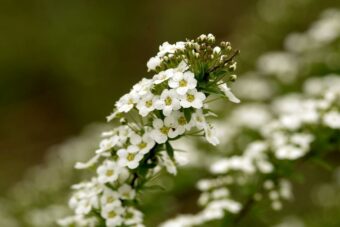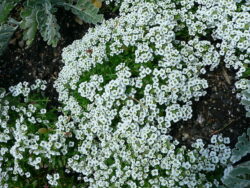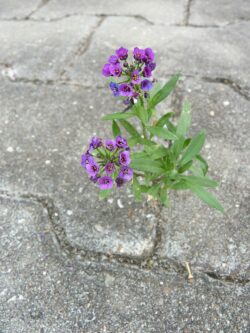In this article, we will be discussing how to grow Lobularia in containers. This is a firm old favourite hardy annual that produces wonderful honey-scented, white flowers. It tends to be low maintenance, trouble-free and produces a profusion of flowers that mingle well with other bedding plants, either in containers or cascading over in hanging baskets.

It has the common name of Sweet Alyssum as the flowers have the most delightful scent. One of the beauty or annoyance of Lobularia is that it self-seeds easily, where it will even grow in cracks in the pavement. Great for those who want a ready supply for next year. It is a plant that is native to the Mediterranean, Canary Islands and the Azores, where it often grows in sunny, rocky areas.
Although the flowers are white, occasionally pinks or lavenders are noted, but alas these are not as heavily scented as the white varieties.
The flowers are produced over a long period of time until the first frosts hit, which are very attractive to bees, butterflies and wasps. The nectar provides good food for tiny, beneficial insects.
Find out how to grow these delightful plants in containers in this article.
HOW TO GROW LOBULARIAS IN CONTAINERS
You can either grow Lobularias from shop-bought plants but it is very easy to grow from seed.
To grow from seed, sow under glass from February to March or you can sow directly in containers in April or May or in autumn to overwinter and emerge in spring.
Fill a seed tray with a good quality seed compost that has been well watered. On top of this, sprinkle the seeds thinly and cover them with a 3mm layer of sieved seed compost. Cover the seed tray with a propagator lid and place it in a warm area.

After 7 to 14 days the seeds will have germinated. Once the seedlings are large enough to handle, you can transplant them individually to 7.5cm pots full of multipurpose compost to grow on. In Mid-May, you can start to harden them off before planting them outside in containers in late May.
At this stage, shop-bought specimens and home-reared plants can be treated in exactly the same way.
FIRST CHOOSE A CONTAINER
First, choose a container that will suit the plants in question and is well-proportioned. Whatever you use make sure that it has plenty of drainage holes and add a 1cm layer of gravel as this will improve drainage. On top of this add good quality, multipurpose compost to which a handful of slow-release fertilizer has been added.
Dig holes that are slightly bigger than the root balls they came in the original containers, making sure that each hole is dug 15cm apart from each other. Place a plant in each hole so that the top of the root ball is at the same level as the top surface of the compost. Backfill with the growing media so that no gaps remain and any that do should be filled with more compost. Firm the plants in and water well.
BEST GROWING CONDITIONS
The annual Lobularia does well in full sun in the UK but in warmer countries, they will need to be grown in partial shade. Once established the plant will tolerate drought but it does better when they are in constant moisture.

This is one plant that does not need much feeding, but a slow-release fertilizer applied at planting should be enough to get the plant through the growing season.
The plant will flower better if it is deadheaded regularly. Overgrown or leggy plants can be cut back to not only improve the look of the plant but it will also produce a new flush of flowers. This is a plant that does best in cool summers than in hot summers.
If this occurs give the plant a light cut back, light watering and an application of liquid- fertilizer to get the plant to prep up, once it has turned cooler again.
PESTS AND DISEASES
Sweet alyssums are not totally pest-free as they can suffer from several pests including slugs and snails, leafhoppers (a minor pest), whitefly and flea beetles. Only use insecticides and slug pellets if pests have been a problem now or in the past.
In terms of diseases, the following are common: downy mildew, club roots, Rhizoctonia rot, stem rot and white blight can be a problem. It is best avoided by improving air circulation around the plant and by planting in fresh compost in containers every year. Affected plants will need to be disposed of.
VARIETIES TO GROW
There are many cultivars with many new varieties being developed all the time.

This includes ‘Aphrodite’ that produces early blooms of apricot, salmon, lemon, red, purple and white.
‘Clear Crystals’ produces highly fragrant lavender, purple and white flowers.
‘Easter Bonnet’ produces early flowers in shades of white, violet, rose and lavender.
‘Pastel Carpet produces flowers that have shades of pink, lavender and off–whites.
‘Rosie O’Day’ produces violet, pretty flowers.
‘Royal Carpet’ produces violet flowers that fade to lavender, creating a bicolour look.
‘Carpet of Snow’ produces white, highly fragrant flowers.
‘New Carpet of Snow’ produces compact white flowers that are still scented but smaller than the original.
‘Snow Crystals’ is a vigorous, mounding variety with large white flowers.
‘Snow Princess’ is a sterile new hybrid that is supposed to be heat tolerant and does not self-seed everywhere.
CONCLUSIONS
In this article, we have discovered how to grow Lobularia (Sweet Alyssum) in containers. As you can see these wonderfully scented plants are colourful and will make great additions to the container garden. As you can see they are easy to grow from seed, easy to look after and easy to care for, as long as you are prepared to deadhead regularly.
A plant that will combine well with other bedding plants, as white is such as neutral colour. If you want to grow a versatile plant for your container display, then this is the plant for you.
If you have any questions or comments that you wish to make on growing Lobelia in containers, please do so in the comment box below.
Happy Lobularia growing.
